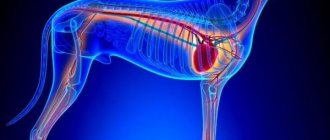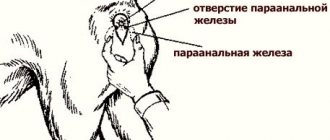Victoria Rashidovna Khazimulina
veterinarian Petstory
Vomiting of bile or yellow foam in a dog indicates serious problems with the pet’s health. Do not put off visiting a doctor, because the condition can quickly worsen. In this article we will tell you why a dog vomits yellow foam or bile, what accompanying symptoms can be caused by certain diseases, why vomiting can only occur in the morning and how to provide first aid to your pet.
Why does a dog vomit bile?
Vomit is yellow in color and usually consists of stomach acid and bile. Gastric juice is produced in the lining of the stomach to aid digestion.
Bile is a fluid produced in the liver and stored in the gallbladder. It enters the duodenum (located just behind the stomach) to further aid digestion.
Free consultation Moscow
+7(495)162-70-70
Here are the five most common reasons why dogs vomit bile:
Common causes of illness
Possible causes of cholecystitis in dogs are divided into 4 large groups. There is also a genetic predisposition in some breeds. The owners of such pets should be more attentive and visit the veterinarian at least once every six months for preventive purposes.
Poor nutrition and obesity
Digestive problems are caused by feeding economy-class food and fatty foods from the human table. The picture is aggravated by non-compliance with drinking norms, as well as a lack of vitamin A and carotene.
The contractility of the muscle reservoir is less in fat animals. Over time, this feature leads to inflammation.
An incorrectly selected diet may also be to blame. For four-legged pets, not only overfeeding, which leads to obesity, is dangerous, but also prolonged starvation.
Poisoning and injury
Another possible reason is food and toxic poisoning. Poisons that enter the body inflame the intestinal mucosa, impair liver function and clog the bile ducts.
The organ can also be directly affected as a result of mechanical trauma. In this case, the damage opens a passage for bacteria and viruses, so the inflammatory process develops against the background of infection.
Infections and pathologies of internal organs
Inflammation is a protective reaction of the body that fights pathogenic microorganisms. This mechanism is triggered by the immune system in response to enteritis, plague and infectious hepatitis.
Often the cause of the disease lies in pathologies of internal organs. In addition to cholelithiasis, these may be congenital anomalies of the bladder itself and its ducts, pancreatitis, colitis, duodenal ulcers or fatty liver.
Infection with worms
Poisoning with harmful substances occurs not only when ingesting spoiled food, medications or chemicals, but also when infected with parasites. Helminths release toxins as a result of their vital activity. As they grow, the patient's condition worsens.
Genetic predisposition
The risk group includes middle-aged and elderly animals. A genetic predisposition to the disease can be traced in representatives of large breeds: mastiffs, German shepherds and terriers.
The tendency to pathology can be inherited. Most often, this pattern occurs in the offspring of dogs who have suffered chronic inflammation.
Biliary vomiting syndrome in dogs
Inflammation in the gastrointestinal tract (stomach and small intestine) may be the reason your dog is vomiting bile. This occurs when circulating fluids dry up.
Your dog's digestive system secretes bile and enzymes even if he hasn't eaten anything. So when your dog has an empty stomach, he may vomit bile soon after he wakes up.
This type of bile vomiting is known as biliary vomiting syndrome. It is also called hungry vomiting. This type of vomiting cools the stomach and lowers the temperature. As dogs age, vomiting is more likely to occur due to an empty stomach.
What should I do?
- Feed smaller portions.
- Give your dog a snack before bed.
Call a veterinarian Moscow
+7(495)162-70-70
Methods for stopping vomiting and treating animals
Treatment begins with assessing the condition of the dog’s body and its vital functions. Vomiting often causes blockage of the upper respiratory tract, which can be life-threatening. The functioning of the cardiovascular system is also weakened. Prolonged vomiting is accompanied by dehydration of the body, therefore, if there are signs of dehydration, emergency assistance must be provided:
- watering is not limited;
- electrolyte solutions are administered intravenously, subcutaneously and other parenterally.
Often when dogs vomit, they refuse water, as this once again provokes an attack. Therefore, the liquid must be supplied in alternative ways. The best remedy is intravenous saline. The daily dose for large breeds can be 2-2.5 liters. In addition to sodium chloride solution, 5% glucose solution, calcium gluconate, hemodez, polyglucin, Ringer's solution are used.
Replacement of fluid loss through the mouth is possible only by stopping the urge to vomit. Until this time, it is necessary to prescribe infusion therapy. The first 2-4 days of parenteral treatment compensate for up to 80% of water losses. It is better to split parenteral administration into several doses; it is recommended to administer the solutions themselves slowly.
Normal feeding of a dog with signs of vomiting is impossible. The use of esophageal tubes only increases peristalsis and secretion, which provokes vomiting.
In the first 24-48 hours, a starvation diet is prescribed. Then porridge with water, lean broths, and fermented milk products are introduced as food. Feeding is carried out in small portions, since the dog regurgitates large pieces due to severe irritation of the stomach.
If the dog is vomiting due to lymphocytic or plasmacytic gastroenteritis, then immunosuppressive drugs are prescribed. In most cases, foamy vomiting in dogs can be controlled with prednisolone and other glucocorticoids.
Vomiting of bile accompanies erosive and ulcerative diseases of the intestines and stomach in dogs, the treatment of which requires special measures:
- cimetidine;
- ranitidine;
- omeprazole;
- sucralfate.
If neoplasms are detected that cause the dog to cough and vomit foam, surgical intervention is required. The tumor and operable metastases with affected tissues are removed. Chemotherapy is also prescribed; in severe cases, radiation therapy is possible.
Reasons why a dog vomits bile:
Feeding dry food
Feed absorbs moisture in the digestive tract, so it can dry out the digestive tract and increase inflammation. This causes the stomach to enlarge and overproduce stomach acids.
What should I do?
If you need to feed your dog food, divide the daily dose into 3 or 4 small meals and feed throughout the day. Water must be freely available.
Pancreatitis in dogs
Pancreatitis in dogs is an inflammatory disease of the pancreas that can lead to abdominal pain, lack of appetite and vomiting. It occurs under the influence of a number of reasons (fatty foods, transfer from one type of diet to another, etc.), and is expressed in the activation of enzymes in the pancreatic parenchyma and its ducts, followed by the digestion of gland tissue.
An attack of pancreatitis with vomiting of bile can occur 24 hours after a food error.
Intestinal obstruction
If they enter the gastrointestinal tract, some foreign bodies (rubber band, foam plastic, bottle caps) may remain in the stomach and periodically block the entrance to the duodenum, causing periodic deterioration of the condition and vomiting. Regular vomiting turns into a dog vomiting yellow bile after its stomach is emptied. Severe loss of energy and severe abdominal pain may indicate an intestinal obstruction.
When a diagnosis of gastrointestinal obstruction is made, urgent surgical intervention is required.
Allergy
Food allergies are a very serious challenge for dogs. While it often appears soon after switching to a new food, in many cases a dog may be allergic to something it has been eating regularly for years.
- Beef
- dairy
- wheat
- eggs
- chicken
- mutton
- soybeans
Do not forget that almost any food ingredient can cause an allergy, regardless of its absence from the proposed list.
Further treatment
It is important for the owner to report all signs of pathology. It is necessary to remember the presence of gastrointestinal diseases, eaten junk food, such as chicken bones. It should be noted when the symptom began and what may have contributed to it. To simplify the diagnosis of the disease, you should notify your veterinarian of the following signs:
- Continuous vomiting of bile, which occurs in the morning and at night.
- Loss of appetite.
- Discomfort in the stomach, which causes the pet to growl and whine.
- Nausea. The dog periodically tenses up, looks at one point, and groans. Her movements indicate that she is about to vomit.
- Diarrhea. It indicates serious disruptions in the digestive processes.
- Exhaustion. Rapid weight loss, sunken eyes, pale mucous membranes, deterioration of coat.
You should also provide information about the consistency of the vomit, its quantity, and color. It is necessary to talk about changes in behavior, the frequency of symptoms, whether they existed before. These nuances can greatly facilitate diagnosis.
The doctor will thoroughly examine the dog. A urine and blood test will be required - this will help determine gastric ailments. Vomiting often indicates an infection, which can be easily detected using the diagnostic methods listed above. If the disease is not detected, an x-ray and ultrasound of the abdominal cavity are prescribed.
Before the x-ray, you need to give your pet barium pulp. It will help determine gastric obstruction, volvulus, and gastrointestinal atony. Gastroendoscopy is also sometimes recommended.
If the exact root cause is not found, symptomatic therapy should be started. A specialist can determine that a single attack does not indicate a serious illness and prescribe Lansoprazole. The dose of the drug is determined individually, but usually it is 30 mg of the drug 30 minutes before meals. But they pay attention to the weight of the dog. The product reduces the concentration of hydrochloric acid and reduces the risk of vomiting. The doctor will also recommend giving food at night so that your pet wakes up less hungry.
Sometimes a specialist prescribes medications with a choleretic effect, such as Odeston. These drugs are allowed to be taken only after an accurate diagnosis.
For hyperacid gastritis, medications are prescribed to reduce acidity. Medicines that relieve spasms of smooth muscles help. First, the pet may be recommended to drink activated carbon or Smecta. They minimize the damage that bile causes to the mucous membrane.
In case of chronic gastritis, along with medications, you will need to follow a diet, which includes the use of special foods. The owner must take into account the upcoming costs, since the cost of diets with a therapeutic effect will be more expensive than standard ones. For hepatitis, they give Allohol. If worms are detected, deworming with drugs is recommended.
Animals usually respond well to therapy. It is necessary to understand that the treatment will be long-term and it is not worth interrupting it abruptly. Only a doctor can determine how long the course lasts. Vomiting often occurs due to the fact that the animal is given a lot of food on an empty stomach. Therefore, experts do not recommend feeding service dogs once a day.
This is especially dangerous for animals that are heavily overloaded. If a fatty and nutritious meal is offered after a day's work when they are hungry, the release of bile can cause damage to the digestive organs and even death due to cholemia.
This also applies to severely malnourished animals. If the owner has adopted a thin dog, there is no need to immediately give huge portions. The best food for her will be broth. The physiology of the dog implies that with a prolonged absence of food in the stomach, atony may develop.
Diseases of the gastrointestinal tract
When a dog vomits bile, it is a sign of a number of conditions affecting the digestive system, including inflammatory diseases, ulcers, parasitic infections and some types of cancer.
- Inflammatory disease
- Parasites
- Ulcers
- Cancer
- Toxic substances
- Bacterial or viral infections
Vomiting bile in dogs can occur for many reasons. If there is bile (sometimes a yellow foamy liquid) in the vomit, if your dog vomits frequently or regularly, or if you notice one or more of the following symptoms in addition to biliary vomiting syndrome, then your dog is in serious danger. We need to take her to the vet as soon as possible.
Diagnostics: tests and other studies
Diagnosis of cholecystitis in dogs involves mandatory palpation of the abdominal cavity. The organ increases in size, so it is easy to palpate. Please note that such actions cannot be performed independently. Without calculating your strength, you can damage the walls of the bubble.
After examination and history taking, the following studies are carried out:
- urine and blood tests showing high levels of bilirubin, immature white blood cells, transaminase and alkaline phosphatase;
- Ultrasound of the abdominal cavity, assessing the amount of bile and the condition of all internal organs.
- X-ray, revealing the presence of stones and injuries;
- biopsy with bile sampling, which determines the type of pathogen in the presence of infection.
After receiving all the results, the four-legged patient is given an accurate diagnosis, indicating the type and form of the disease. This helps to choose an effective treatment method for each case.
What to do
If your dog has only vomited yellow bile once, don't be discouraged. Monitor your dog for lethargy, diarrhea, loss of appetite, weakness, and other signs of illness. If your dog seems normal, monitor the amount of elimination. If vomiting persists, skip your dog's next food and continue to observe.
If vomiting continues, consult your veterinarian. This course of action is suitable for any type of vomiting. Therefore, do not be surprised if you find similar text in other articles on our website regarding vomiting in dogs, because the action plan is practically no different.
Bile consists of water, lecithin, cholesterol, bicarbonate ions, pigments and bile salts. Therefore, yellow vomit may mean that bile has entered the stomach. This usually occurs if the diet included foods rich in fat or a significant amount of grass.
Rules of a therapeutic diet
After fasting, the pet is transferred to fractional meals. He is fed at least 4 times a day in small portions so as not to overload his stomach. All food is served in ground and liquid form.
The patient's diet should include the following products:
- vegetables (carrots, pumpkin, broccoli) enriched with carotene and vitamin A;
- lean meat (veal, turkey, rabbit);
- rice porridge, which helps cleanse the kidneys and liver;
- buckwheat, which improves intestinal motility;
- low fat fermented milk products;
- eggs.
Dry dog food for cholecystitis should be purchased from a special veterinary line marked i/d or l/d. Such products facilitate digestion, reduce the load on the liver and reduce the amount of harmful substances produced during metabolism.











